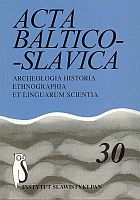О типологической близости легнд о происхождении Турова и Вильни
About the Typological Similarity of the Legends about the Foundation of the Towns of Turov and Vilnius
Author(s): Andrej ProhorovSubject(s): Language and Literature Studies
Published by: Instytut Slawistyki Polskiej Akademii Nauk
Keywords: oral legend; mythology; town foundation; cosmological motive; Dukes power
Summary/Abstract: The legend about the foundation of Vilnius / Vilnius is well-known and the scholars have paid much attention to this legend. The oral legends about the foundation of Turov, ancient Belarusian town were fixed only in the end of the 19th and the beginning of 20th centuries. On the contrary, they have never been a subject of scientific research. Turov is the former capital of the Dregovichi Slavic tribe. The legends tell that Duke Tur reached a forest country abundant in wildfowl and slew the aurochs. During his night dream here he saw himself at a raised cart and decided that it was a sign to build a capital town at this place. The Duke ordered to dig out the Tur-well and to throw up the Tur-hill, on which the fortified center of the medieval Turov was settled down. According the legends the Tur-well has gold, silver and copper bottoms. The world will be destroyed and covered by water in the case of a destruction of this construction, when the last well bottom will break. There are some arguments which can specify an ancient origin of the Turov legends. The mention under the year 980 in "The Primary Chronicle," as well as the oral legends link the foundation of the town with Duke Tur. The important argument is that in the beginning of the last century inhabitants showed some objects, mentioned in the legends, on the concrete topography of Turov. The name Tur is carried with the well, the dell, sometimes with any, unknown now river. The legends connect directly such the most popular and steady toponyms with the activity of Duke Tur such as the Tur-well and the Tur-hill. The brief forms of the toponyms – Tur – certainly specify its ancient origin. At last, the oral tradition represents the archaic pre-Christian, pagan motives, which have analogs in folklore and fairy tales. Despite of a fragmentariness of the Turov legends we can notice the stability of oral tradition. Moreover, the oral tradition is alive and modifies till now. The complex of the legends keeps constant and very indicative structure which we could present as a macrotext for analysis. An integral part of this macrotext is the topography of Turov. It is possible to pick out few representative features in these foundation legends, which are always connected with mythological and cosmological motives and played an important role. Duke Tur acted as a creator of a sacral-ordered space in wild lands. Thus, during the building of the town a world axis with the Tur-hill and Tur-well was created. Destruction of this axis should destruct the whole world. The sacral character of the Duke’s actions is also emphasized by a prophetical dream, which is a divine oracle simultaneously. This fortune-telling clearly predetermined the great future of new town. The time and the place of this oracle are also important: a foundation of the town on a place of successful hunting is very frequent motive in many mythological traditions. Thus, the dream of Duke Tur on a cart, lifted into the air....
Journal: Acta Baltico Slavica
- Issue Year: 2006
- Issue No: 30
- Page Range: 611-626
- Page Count: 16
- Language: Russian

